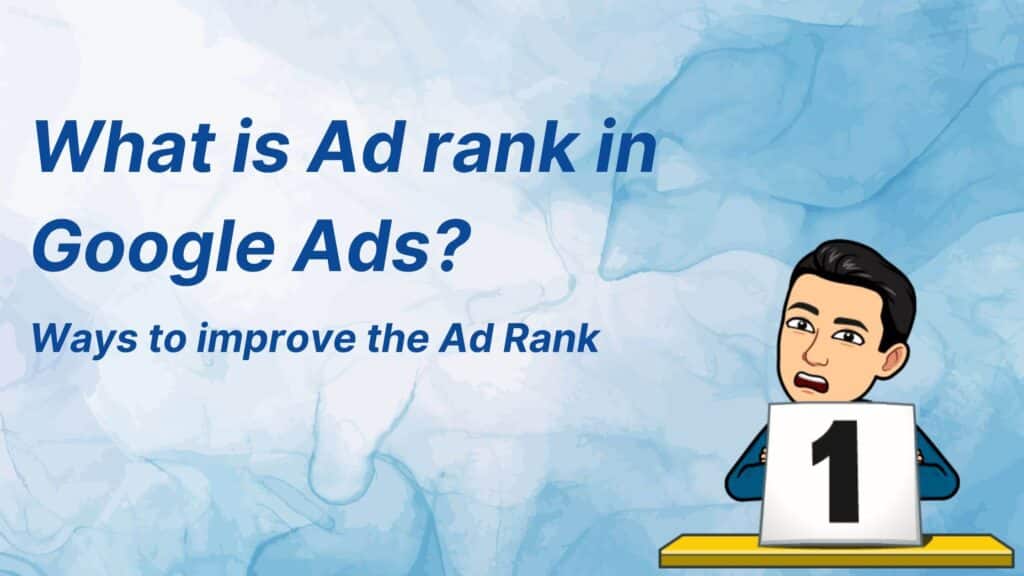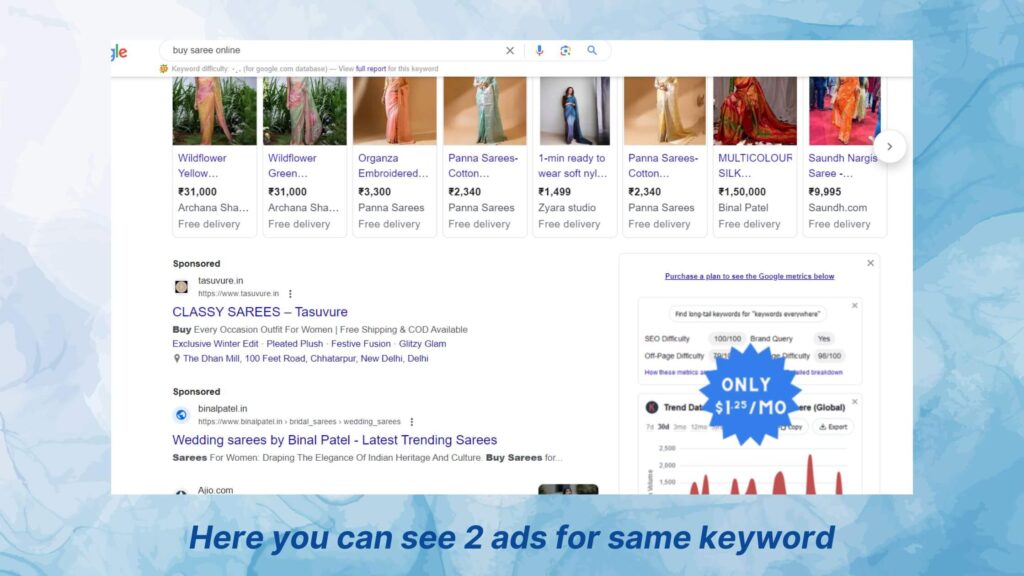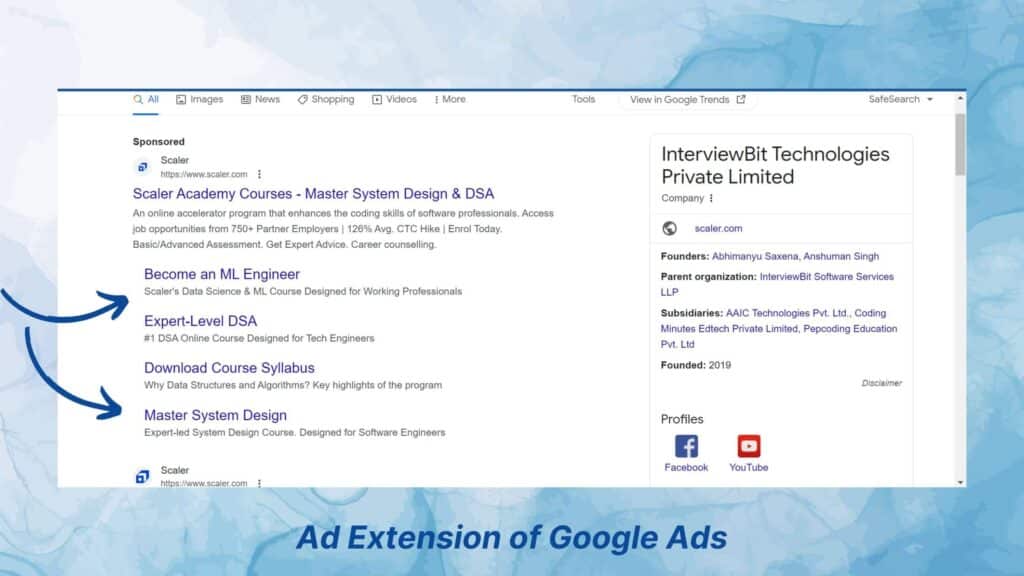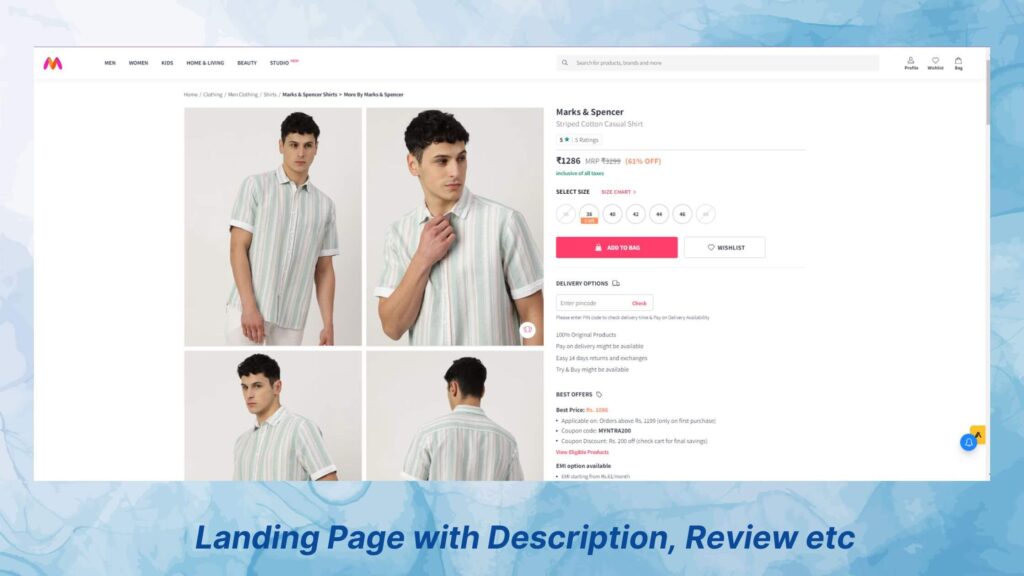
Thank you for taking the time to check out my post, Want me to audit your campaigns on Google and Facebook?

Thank you for taking the time to check out my post, Want me to audit your campaigns on Google and Facebook?

Ad rank in Google Ads is one of the most important topic which you must know if you want to perform better for good ROI.
In the dynamic world of online advertising, achieving prominence in Google Ads is crucial for businesses aiming to maximize their online visibility and drive meaningful results. At the heart of this endeavor lies the concept of Ad Rank – a pivotal factor determining the position of your ads in Google’s search results. In this comprehensive guide, we will unravel the mysteries of Ad Rank and provide actionable strategies to elevate your Google Ads game.
The definition of ad rank remains consistent over the years: it’s the metric determining your ad’s position on Google Search compared to other ads.
Although we understand ad rank’s significance in ad placement, it’s essential to delve into the specific factors influencing it. What comprises the ad rank calculation? What aspects can you manipulate to enhance your ad rank? If you’re uncertain where to commence in boosting your ad rank, this guide is tailored for you.
Ad rank in Google Ads might appear as a straightforward computation, yet elevating it can feel like an uphill challenge.
Discover all the essentials about ad rank, its significance, and effective methods to enhance it without escalating your expenditure.
You need to understand that, on search ads there are lots of companies who are running ads. For e.g. if you search buy saree, then you are going to see lot of companies who are running ads for the same keyword.
How Google decides which ads should come on rank 1, rank 2 and so on…….
Let’s deep dive into the Google Ads and How Google decides which ad should come on the different ranks.

It mainly depends on the Quality Score and bid amount.
This calculation happens so fast, which decides the ad rank of your campaign.
Bid: It is nothing but the amount that you are ready to give to Google for your campaign. As we know Google is user-oriented, hence Google always wanted to show relevant ads to its audience. The quality score determines how your ads are relevant. If you are paying more but your quality score is not that good then your ad won’t come at the rank at which you want.
Since every marketer and business owner wants to have top rank for their campaign, therefore, it is important to keep the quality score and bid amount at a great point.
In the above image, you can see a search ad, where I searched for a keyword and two different results came for it.
It is score which is given by google after seeing your ad copies, campaign, audience, landing page and many more things. This score ranges from 1-10. So It is recommended to have a good quality of ad copies, campaign, audience and other things.
Let’s see and focus on those metrics which you can use to improve your quality score
Consider two brands who are running ads on the same keywords, let’s say it is women silver necklace.
Assume that keywords of 1st brand is searched 100 times, and same for the 2nd brand but the out of those 100, 5 people click on the ad at the time of 1st brand and 10 people click on the ad at the time of 2nd brand.
Here, we know the concept of bid and most of the times marketers and business owners likes to bid on clicks, which means they will pay based on the click that they got.
That’s why most of us people call it as PPC.
Assume that the CPC (Cost per Click) is Rs.10 for each brand so google will going to earn Rs.50 from brand 1 and Rs.100 from brand 2.
But why more people are clicking on the ad of brand 2?

Setting up new campaigns and ad groups often leads to overlooking ad extensions. Although they might appear tedious or unimportant, the opposite holds true.
Ad extensions play a crucial role in boosting your ad rank in Google Ads by enhancing your Click-Through Rate (CTR).
You may wonder, why do they contribute to increased CTR? Ad extensions provide an opportunity to furnish users with additional information about your business that might be challenging to convey within the limitations of headlines and descriptions.
However, adding extensions indiscriminately is not advisable. If extensions don’t align with the search terms, they could potentially lower your ad rank.
The versatility of ad extensions allows you to convey almost anything. Google consistently introduces new ways for advertisers to communicate their messages effectively to users seeking solutions.
Presently, the available ad extensions include:
Given these options, the challenge lies in choosing the right ones. Ideally, create ad extensions based on your campaign goals. For instance:
Local businesses aiming to drive in-store traffic benefit from adding location extensions.
Those focused on increasing web traffic can incorporate relevant sitelinks to different sections of their site.
For lead generation goals, adding a lead form extension proves effective, particularly if your landing page isn’t optimal.
In summary, be selective and specific when adding extensions to your campaigns. Aligning them with your campaign goals can significantly enhance your ad rank.
Improving the relevance of your ads in Google Ads is crucial for achieving better performance and maximizing your return on investment. Here are several strategies to enhance the relevance of your ads:
Conduct thorough keyword research to identify the most relevant and high-performing keywords for your business. Use tools like Google Keyword Planner to discover keywords that align with your products or services.
Group your keywords into specific ad groups based on their relevance. This allows you to create tailored ad copy that directly addresses the user’s search intent, improving overall ad relevance.
Write compelling and engaging ad copy that clearly communicates the value proposition of your product or service. Highlight unique selling points and benefits to capture the attention of potential customers.
Ensure that the content of your ad aligns seamlessly with the content on your landing page. Consistency between your ad copy and landing page helps improve the user experience and reinforces the relevance of your ad.
Implement negative keywords to filter out irrelevant traffic. This ensures that your ads are shown to users who are more likely to find your products or services valuable, improving overall relevance.

Ensuring the relevance of a landing page is a critical aspect of optimizing Ad Rank in Google Ads. When a user clicks on an advertisement, their expectation is a seamless transition from the ad content to the landing page, where they find information that aligns closely with their original search intent. This alignment is not just user-friendly; it is a fundamental factor that Google’s algorithms consider when determining Ad Rank.
Google’s commitment to providing users with a positive experience translates into rewarding advertisers who deliver on this promise. The relevance of a landing page directly influences the overall quality of the ad, impacting its Quality Score. The Quality Score, in turn, plays a pivotal role in determining the Ad Rank – a metric that determines the ad’s position on Google’s search results page.
A landing page that is consistent and relevant to the ad not only satisfies user expectations but also increases the likelihood of conversions. Users are more likely to engage with a landing page that provides the information they were seeking, leading to a more positive user experience and potentially higher conversion rates.
The connection between a relevant landing page and Ad Rank becomes evident when considering how Google’s algorithms evaluate landing page content. A high-quality landing page, rich in relevant content and aligned with the ad’s messaging, contributes positively to the Quality Score. Google’s algorithms analyze various factors, such as the landing page’s relevance, loading speed, and mobile-friendliness, to ensure that users are directed to pages that meet their needs.
A higher Quality Score not only enhances the ad’s position on the search results page but also lowers the cost per click (CPC). Advertisers with higher Quality Scores often enjoy better ad placements while paying less for each click, making efficient use of their advertising budget.
The importance of a relevant landing page becomes even more pronounced in the context of user behavior and expectations. Users today are more discerning and have a lower tolerance for irrelevant or poorly designed landing pages. A landing page that fails to deliver on the promises made in the ad may result in a swift exit from the page, negatively impacting bounce rates.
To optimize Ad Rank and achieve better results, advertisers should focus on several key practices:
Consistent Messaging: Ensure that the messaging in the ad is closely aligned with the content on the landing page. Consistency builds trust and reinforces the relevance of the information.
Relevant Content: Provide valuable and relevant content on the landing page that directly corresponds to the user’s search intent. This not only satisfies the user but also signals to Google that the page is authoritative and useful.
User-Friendly Experience: Optimize the landing page for a seamless and user-friendly experience. Fast loading times, easy navigation, and mobile responsiveness contribute to a positive user experience.
Clear Call-to-Action (CTA): Guide users on the next steps by incorporating a clear and compelling call-to-action. A well-designed CTA can influence user behavior and drive desired actions.
Continuous Monitoring and Optimization: Regularly monitor the performance of the landing page through analytics tools. Analyze user behavior, identify areas for improvement, and make data-driven optimizations.
The speed of a website is a pivotal factor in optimizing Ad Rank within the Google Ads ecosystem. In an era where users demand instant access to information, the loading speed of a website directly influences user experience and, consequently, plays a significant role in determining Ad Rank.
Google’s commitment to delivering a positive user experience extends to the speed at which websites load. Slow-loading websites not only frustrate users but also compromise the overall quality of the advertising ecosystem. Therefore, Google’s algorithms consider the loading speed of a website as a crucial metric in evaluating the relevance and effectiveness of an ad.
A fast-loading website contributes to a positive user experience, reducing bounce rates and increasing the likelihood of user engagement. Users are more likely to interact with content when it is swiftly accessible, leading to longer on-page durations and improved conversion rates.
The correlation between website speed and Ad Rank becomes apparent when considering the impact on the Quality Score. Google’s algorithms assess various factors, including the loading speed of the landing page, to determine the overall quality and relevance of the page. Websites with faster loading times are often rewarded with higher Quality Scores, resulting in better Ad Rank and improved visibility on the search results page.
Beyond its influence on Ad Rank, website speed also affects other key metrics, such as user satisfaction, bounce rates, and conversion rates. A slow website can deter users from exploring further, leading to higher bounce rates and a potential loss of valuable traffic. Conversely, a fast-loading website provides a seamless and efficient user experience, positively impacting user satisfaction and encouraging continued engagement.
To optimize website speed and enhance Ad Rank, advertisers should prioritize the following practices:
Optimize Images and Multimedia: Compress images and multimedia files to reduce their file sizes without compromising quality, ensuring faster loading times.
Minimize HTTP Requests: Reduce the number of HTTP requests by minimizing the use of external scripts, stylesheets, and plugins, streamlining the loading process.
Browser Caching: Implement browser caching to store static files on users’ devices, allowing for quicker loading upon subsequent visits.
Content Delivery Network (CDN): Utilize a CDN to distribute website content across multiple servers globally, reducing latency and accelerating loading times for users in different locations.
Mobile Optimization: Prioritize mobile optimization to cater to users accessing the website from various devices. Mobile-friendly websites often load faster and provide a better user experience.
Code Optimization: Streamline and optimize website code to eliminate unnecessary elements and enhance the efficiency of the loading process.
Regular Performance Monitoring: Employ performance monitoring tools to assess website speed regularly. Identify areas for improvement and implement optimizations based on data-driven insights.
The speed of a website is not only a crucial element in delivering a positive user experience but also a strategic imperative for advertisers aiming to optimize their Ad Rank in Google Ads. By prioritizing website speed and implementing best practices for optimization, advertisers can not only improve their Ad Rank and visibility but also cultivate a favorable user experience, ultimately leading to increased engagement and conversions.
Not just these factors but there could be more metrics that you need to focus on, like Ad account history.
If you had a bad ad account history in the past, Google would give you a lower quality score.
Bad ad account history means if in the past your campaigns have not performed well, most of your ads were disapproved then Google will also going to rate your account less.
Since Google will always be skeptical about your ad account therefore it is recommended to start a fresh ad account. The performance of your domain also going to impact the quality score.
hope you learned about Ad rank in Google Ads, Do let me know what do you think about this ?
Till Then,
Rajat “Increasing Ad Rank in Google Ads” Negi